m-Tolidine, an aromatic diamine derived from toluene, is a key chemical intermediate valued for its reactivity and versatility in producing high-performance materials like polyimides (PI), which are critical in electronics, aerospace, and industrial applications. Its ability to form stable, heat-resistant polymers distinguishes it in the specialty chemicals sector, though its use is tempered by toxicity concerns and regulatory scrutiny. The market is niche, driven by demand for advanced materials in high-tech industries, with trends focusing on safer handling, sustainable alternatives, and precision manufacturing.
Europe’s regulatory landscape encourages local production, with firms like Seika Group potentially expanding European partnerships, though this strains short-term profitability. In Asia Pacific, Chinese players like Chinatech and Henan Daken face export challenges, prompting investment in Southeast Asian hubs to evade tariffs, risking quality consistency. This shift enhances regional resilience but complicates global pricing and supply dynamics, fostering localized innovation amid trade uncertainties.
This product will be delivered within 1-3 business days.
Market Size and Growth Forecast
The global m-tolidine market is estimated at USD 15 million to USD 20 million in 2025, with a CAGR of 3% to 4.5% from 2025 to 2030, reaching USD 18 million to USD 25 million by 2030.Regional Analysis
Asia Pacific holds 50-55%, growing at 3.5-5%. China leads with robust polyimide production for electronics, trending toward high-tech manufacturing, while Japan follows with precision applications. North America accounts for 20-25%, growing at 2.5-3.5%. The U.S. drives demand in aerospace and tech, focusing on safety compliance. Europe represents 15-20%, growing at 2.0-3%. Germany emphasizes industrial uses, trending toward sustainable alternatives. The Rest of the World holds 5-10%, growing at 3.0-4%, with India expanding in specialty chemicals.Application Analysis
Polyimide (PI) dominates with 70-75%, growing at 3.5-5%, driven by electronics and aerospace, with trends in flexible displays. Others, like dyes, account for 25-30%, growing at 2.0-3%, with declining trends due to regulatory limits.Key Market Players
- Seika Group: A Japanese innovator delivering m-tolidine for advanced material solutions.
- Luminescence Technology: A Taiwanese specialist crafting high-purity m-tolidine for tech industries.
- Chinatech (Tianjin) Chemical: A Chinese leader supplying m-tolidine for industrial applications.
- Henan Daken Chemical: A Chinese expert producing m-tolidine for specialty polymers.
- Yurui (Shanghai) Chemical: A Chinese pioneer enhancing m-tolidine for diverse uses.
Porter’s Five Forces Analysis
- Threat of New Entrants: Low. High technical barriers and regulatory hurdles deter entry, though niche demand attracts specialized firms.
- Threat of Substitutes: Medium. Safer diamine alternatives compete, but m-tolidine’s performance in polyimides sustains its niche.
- Bargaining Power of Buyers: Medium to High. Tech firms demand quality and compliance, leveraging limited suppliers to negotiate terms.
- Bargaining Power of Suppliers: Medium. Specialized raw material suppliers hold sway, but manufacturers diversify to manage costs.
- Competitive Rivalry: Medium. A small pool of players competes on quality and innovation, with rivalry tempered by niche focus.
- Impact of Tariff Conflicts on Supply Chain Localization
Europe’s regulatory landscape encourages local production, with firms like Seika Group potentially expanding European partnerships, though this strains short-term profitability. In Asia Pacific, Chinese players like Chinatech and Henan Daken face export challenges, prompting investment in Southeast Asian hubs to evade tariffs, risking quality consistency. This shift enhances regional resilience but complicates global pricing and supply dynamics, fostering localized innovation amid trade uncertainties.
Market Opportunities and Challenges
Opportunities
- Electronics growth: Rising demand for polyimides in flexible circuits and displays drives m-tolidine use, tapping into tech innovation trends.
- Aerospace expansion: High-performance polymers for lightweight components offer growth, aligning with aerospace advancements.
- Emerging markets: Industrialization in India and Southeast Asia boosts specialty chemical demand, leveraging cost-effective production.
- Process innovation: Advances in safer synthesis enhance market appeal, addressing regulatory pressures and expanding applications.
Challenges
- Toxicity concerns: Health risks and regulations limit use, requiring costly safety measures and alternative exploration.
- Substitute pressure: Safer diamines threaten market share, pushing firms to justify m-tolidine’s value in high-performance niches.
- Regulatory complexity: Diverse global standards increase compliance costs, slowing expansion in tightly controlled regions.
- Supply chain risks: Tariff-driven disruptions challenge raw material access, necessitating adaptive strategies to maintain stability.
This product will be delivered within 1-3 business days.
Table of Contents
Chapter 1 Executive SummaryChapter 2 Abbreviation and Acronyms
Chapter 3 Preface
Chapter 4 Market Landscape
Chapter 5 Market Trend Analysis
Chapter 6 Industry Chain Analysis
Chapter 7 Latest Market Dynamics
Chapter 8 Trading Analysis
Chapter 9 Historical and Forecast M-Tolidine Market in North America (2020-2030)
Chapter 10 Historical and Forecast M-Tolidine Market in South America (2020-2030)
Chapter 11 Historical and Forecast M-Tolidine Market in Asia & Pacific (2020-2030)
Chapter 12 Historical and Forecast M-Tolidine Market in Europe (2020-2030)
Chapter 13 Historical and Forecast M-Tolidine Market in MEA (2020-2030)
Chapter 14 Summary For Global M-Tolidine Market (2020-2025)
Chapter 15 Global M-Tolidine Market Forecast (2025-2030)
Chapter 16 Analysis of Global Key Vendors
List of Tables and Figures
Companies Mentioned
- Seika Group
- Luminescence Technology
- Chinatech (Tianjin) Chemical
- Henan Daken Chemical
- Yurui (Shanghai) Chemical








